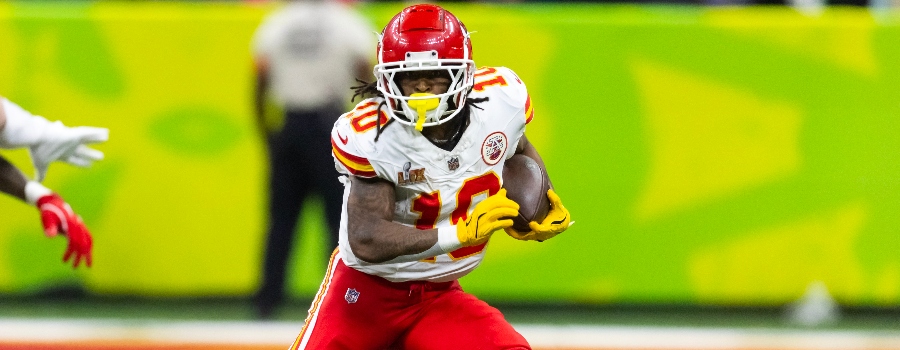If you have been playing fantasy football for a few seasons, you have probably come across chatter about “Zero RB.” But what exactly is this zero running back strategy and how can it give fantasy owners an edge on draft day—or how does it stack up against the Hero RB draft strategy?
Below is an in-depth analysis of the Zero RB strategy, including players who fit the draft strategy that you can target this season, whether it be re-draft leagues at Sleeper Fantasy or Underdog Best Ball drafts.
Speaking of fantasy leagues…check out our Sleeper promo code for a $100 deposit bonus this football season!
And don’t forget to sign up for your fantasy football league on Yahoo Sports!
What is Zero RB Strategy?
Despite its name, the Zero RB strategy does not mean fantasy football owners should completely ignore the running back position on draft day or be bold enough to leave those positions blank in a starting lineup.
In general, Zero RB strategy prioritizes other positions in the early rounds of the draft to build a stud-wide receiving corps and secure difference-makers at the quarterback and/or tight end spots. Although the specific round threshold for a pure Zero RB strategy is arguable, waiting until the fifth round or later to draft a running back fits the concept.
The running back position is generally the most volatile throughout the season with injuries. Backups entering starting roles routinely see workloads that generate impactful fantasy points, regardless of their talent levels. The Zero RB strategy seeks to take advantage of the running back volatility by minimizing draft capital on high-end backs and taking more shots on late-round backs with high upside.

Pros of Zero RB Strategy
There are a few alluring pros of the Zero RB strategy making it popular among daring fantasy drafters. An obvious positive is the strength built at the other positions when teams forego the running back spot. Specifically, the strategy makes it easier for fantasy players to prioritize the single starting positions at quarterback and tight end.
Brock Bowers in the second round and/or the likes of Lamar Jackson, Josh Allen, or Jalen Hurts in the early rounds of single-quarterback leagues become draft targets instead of wrenches thrown in the draft plan. The positional advantage of those superstars is enticing, but many fantasy players are reluctant to invest a high-end pick on those positions. The Zero RB strategy opens up the flexibility to load up on these fantasy difference makers.
Running backs also tend to get injured at a higher rate than most other positions. Each year, multiple first-round running backs wind up on the injured reserve and their fantasy owners’ title hopes are also sidelined. Even an elite option like Christian McCaffrey has multiple years with major mid-season injuries. The Zero RB strategy shies away from the risk of top-tier running backs ruining your fantasy football hopes and leans toward investing in safer positions from an injury perspective. Finally, the Zero RB strategy takes advantage of the volatility potential of the running back position. When an injury occurs in the backfield, the next guy up generally receives a significant workload, at least compared to wide receivers. These backups can provide huge fantasy production with late-round draft capital. Without an early-round runner, the Zero RB strategy relies on taking multiple lottery ticket shots at the position in the late rounds. When those hit, they can be league winners at bargain prices. Just last year, Chase Brown surprised everyone with a top-10 PPR season at the position as he emerged to lead a muddy backfield in Cincinnati.
Of course, there are downsides to the strategy as well. First, those lottery ticket late-round running backs must hit for a chance at a fantasy championship. Loading the bench with timeshare and backup running backs could result in a variety of starting options throughout the season or could turn into a difficult choice each week between disappointing assets.
Speaking of those late-round running backs, the Zero RB roster construction usually means your week one starting lineup is going to look bad at the running back spots. But that’s the idea, right? Hopefully, you have amassed an incredible starting squad in the rest of the lineup, but be prepared to hold your nose while searching for a RB2 (and maybe a RB1) for the first few weeks of the season until injuries start to take shape.
Maybe the worst potential outcome is a major injury to a top-end quarterback or tight end in a Zero RB lineup. The goal of this draft strategy is to grab superstars at the other positions early and then focus on running backs in the back half of the draft. This likely means depth at quarterback and tight end was sacrificed in the process. A season-altering injury at your positions of strength will have an even bigger impact on this strategy when your running backs are not able to overcome the loss in production.
Dominate your Best Ball and season-long fantasy football leagues with our brand-new app that’s available in the Apple App Store and on Android!

Cons of Zero RB Strategy
For a true Zero RB strategy, many fantasy players will advise waiting until at least the fifth round to take the first running back. Of course, there is no fantasy football czar waiting to destroy you if you take Kenneth Walker III in round three or four instead.
The best advice for any draft strategy is to take advantage of the value on the board. If there is a screaming value for a running back in the first three rounds, the Zero RB strategy should go out the window. But for fantasy owners wanting to stick to the strategy at all costs, the general advice is to acquire your starting wide receivers, quarterback, and tight end prior to drafting a tailback.
Looking for a new site for your season-long drafts? Check out our Sleeper Fantasy promo code and get a $100 bonus when you sign up to play their over/under games.
Top Zero RB Targets in 2025
In round five or six, a number of starting running backs are still available for consistent production, though likely not high-end results. Here are a few mid-round targets that could serve as RB1 in a Zero RB strategy:
Isiah Pacheco, RB, Kansas City Chiefs
Coming off an injury-plagued 2024, Isiah Pacheco is back healthy and seems drastically undervalued in the sixth round of fantasy drafts for the upside he has shown in his career. The former seventh-round NFL draft pick finished 15th in PPR scoring in 2023 and looked primed for a massive season last year before the injuries. He should be able to overcome his backfield competition of Kareem Hunt and Elijah Mitchell.
And don’t forget to check out Koerner’s RB Tiers and Rankings for a more in-depth look at his RB thought process.
Kaleb Johnson, RB, Pittsburgh Steelers
Rookie running backs make excellent Zero RB targets in the mid-rounds due to their wide range of outcomes. Former Iowa tailback Kaleb Johnson should be immediately thrust into the early-down role vacated by Najee Harris and could push Jaylen Warren for a bigger share of the receiving work.
Late Round RB Targets in 2025
Remember, the goal is to load the bench with upside running backs in the back half of the draft. Here are a few late-round dart throws that could materialize throughout the season to overtake that RB1 spot in your weekly roster.
Cam Skattebo, RB, New York Giants
Another rookie running back with a wide range of outcomes, reports from Giants training camp have been glowing for the Arizona State product. Cam Skattebo was a goal line bruiser in college and looks to immediately earn carries in high-value scoring opportunities. If he can round out his game through the air, Skattebo could be a massive value late in the draft. Tyrone Tracy Jr. and Devin Singletary have each shown flashes in their careers, but certainly shouldn’t scare fantasy owners off the Skattebo scent.
Jordan Mason, RB, Minnesota Vikings
Former 49ers backup tailback Jordan Mason may find himself with better touch opportunities in Minnesota. Aaron Jones Sr. still claims the top rung in the backfield, but expect Mason to take a bigger share than expected with Jones Sr. now 30 years old. The Vikings vastly improved the interior of their offensive line in the offseason and will lean on a running game with pseudo-rookie J.J. McCarthy taking the helm for his first campaign. Any injury to Jones Sr. and Mason could make them top-10 fantasy backs.
Pictured: Isiah Pacheco
Photo Credit: Imagn






